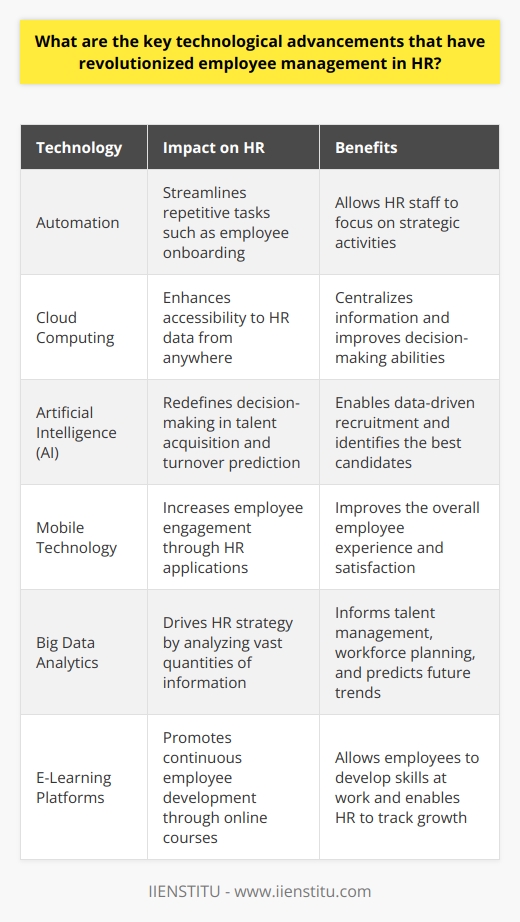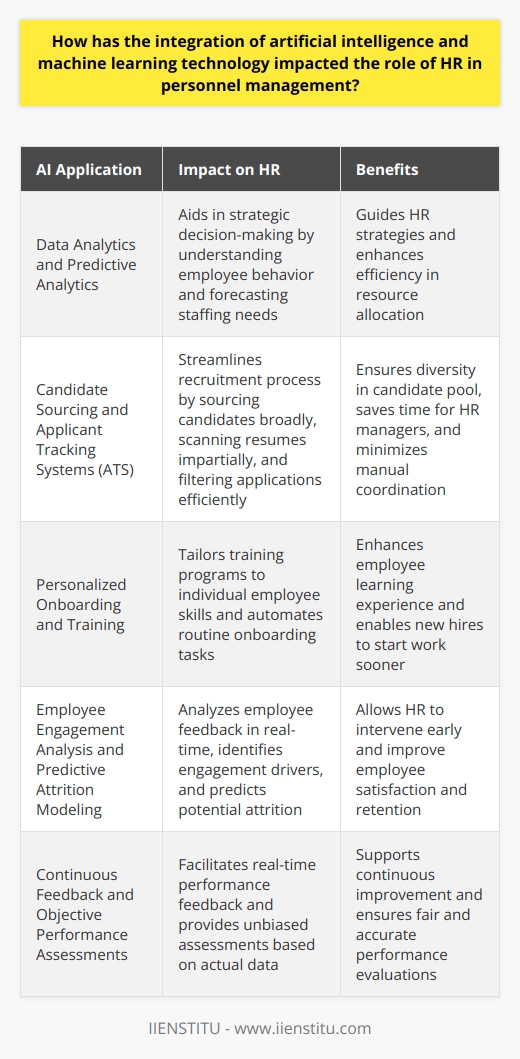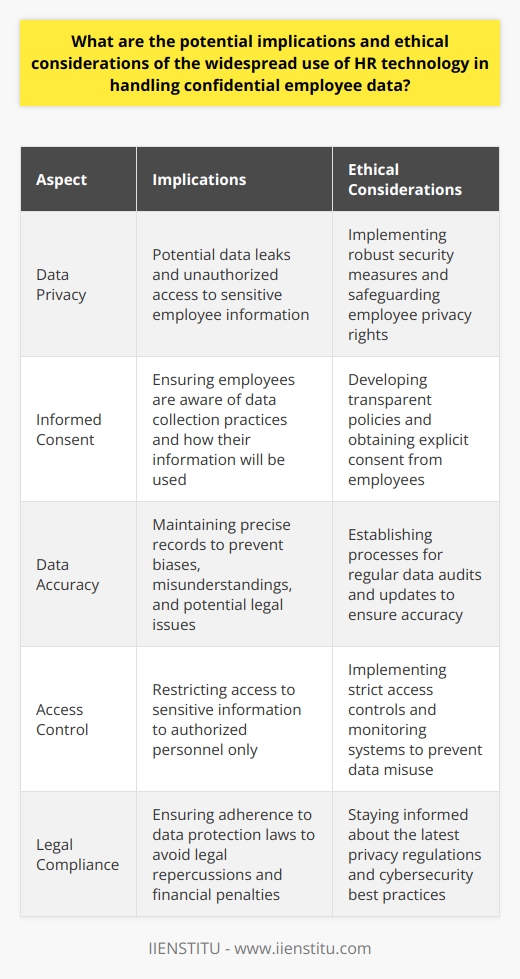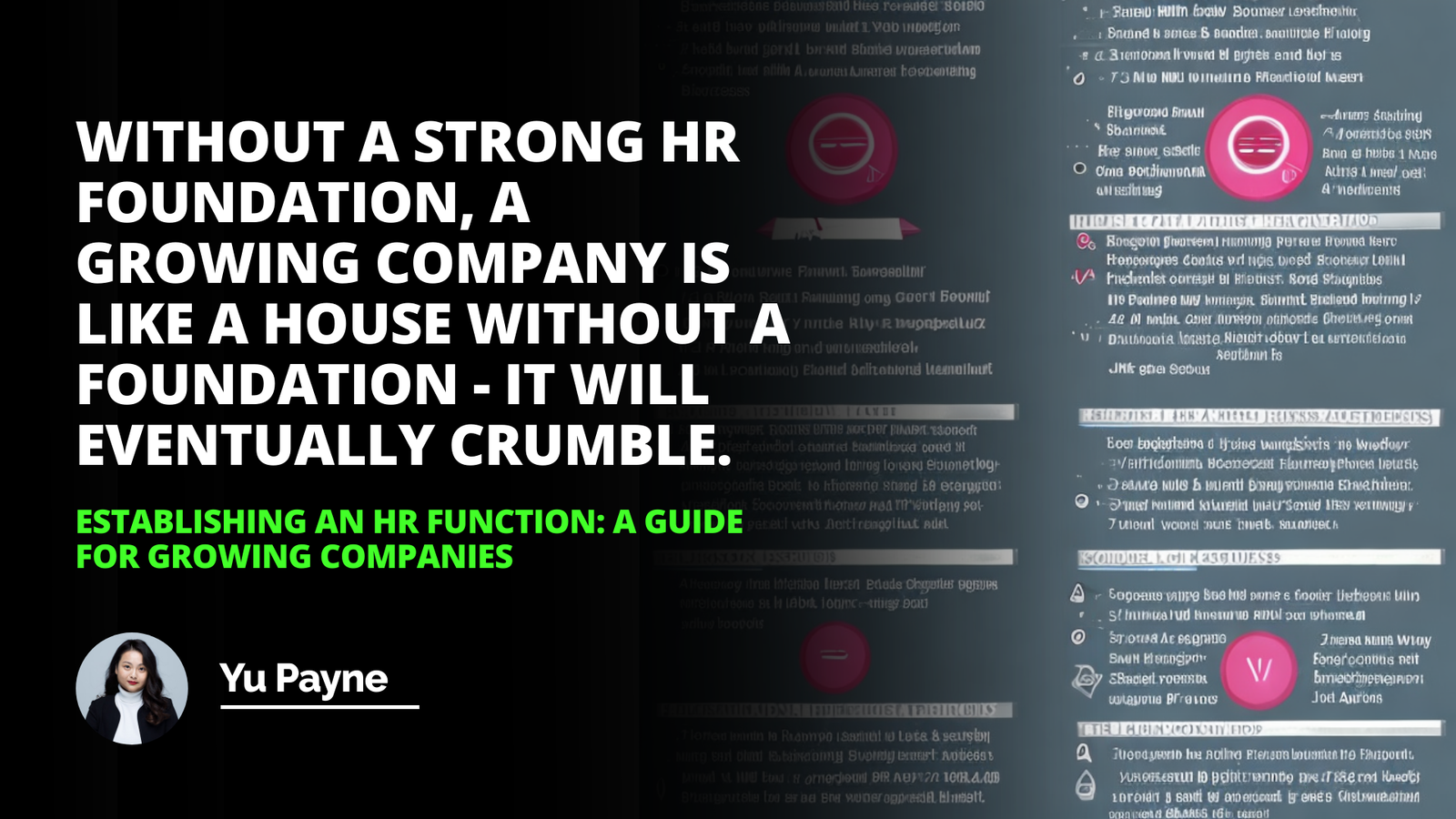
I remember when I first started working in HR over a decade ago, managing employee records felt like trying to juggle while riding a unicycle—chaotic and prone to mistakes. HR technology wasn't as advanced back then, and everything was painstakingly manual. Fast forward to today, and the landscape has changed dramatically. HR technology has revolutionized how we manage employees, bringing efficiency, accuracy, and even a bit of fun into our daily tasks.
Understanding HR Technology
Definition and Components of HR Technology
At its core, HR technology refers to the blend of software, hardware, and cloud-based solutions designed to automate and streamline human resource management. This includes everything from HR software that handles payroll and benefits to HR analytics tools that provide insights into workforce trends. These components work together to create a cohesive system that makes managing people a whole lot easier.
Brief History and Evolution of HR Technology
It's fascinating to think about how far we've come. Back in the day, we relied on filing cabinets and endless paperwork. The introduction of basic HR software was a game-changer, but it still had its limitations. Now, with advancements like AI and machine learning, HR technology is more intuitive and powerful than ever. It's not just about automating tasks anymore; it's about leveraging data to make smarter decisions.
Different Types of HR Technology
HR Software
This is the bread and butter of HR tech. From handling payroll to tracking employee performance, HR software solutions are essential. I recall implementing a new system in our office last year, and despite some initial hiccups, it transformed our processes.
HR Analytics Tools
Data is king, right? HR analytics tools help us dive deep into employee data, uncovering patterns we might miss otherwise. They allow us to predict turnover rates, identify training needs, and even boost employee engagement.
Self-Service Tools
Empowering employees is crucial. With self-service tools, staff can update their information, request leave, and access pay stubs without having to go through HR every time. It saves everyone time and fosters a sense of autonomy.
HR Mobile Applications
In today's mobile world, having access to HR functions on-the-go is a must. HR mobile applications ensure that both managers and employees stay connected, no matter where they are. I can't count how many times I've approved time-off requests from my phone while out of the office.
The Role and Benefits of HR Technology in Business Operations
Implementing HR technology solutions for employee engagement has been a game-changer for many businesses, mine included. Here's how:
Efficient and Accurate Data Management
No more lost paperwork or outdated spreadsheets. Everything is stored securely in one place.
Streamlining HR Tasks and Processes
Automation takes care of repetitive tasks, freeing up time for more strategic initiatives.
Employee Empowerment Through Self-Service
Employees appreciate having control over their own information and processes.
Enhanced Decision-Making with HR Analytics
Making data-driven decisions leads to better outcomes for the company and its people.
Improved Recruitment and Onboarding Processes
Finding and bringing on new talent is smoother and more efficient than ever.
Real-world Examples and Case Studies
Take, for instance, a small business I consulted for. They were drowning in administrative tasks until they adopted a comprehensive HR software. Not only did their efficiency skyrocket, but employee satisfaction improved because processes were clearer and more transparent.
Key Considerations in Selecting HR Technology
When it comes to choosing the right HR tech, it's not a one-size-fits-all situation. Here's what to keep in mind:
Understanding Your Unique HR Needs
Every organization is different. Assess what your specific challenges and goals are.
Cost vs. Benefits Analysis
Weigh the upfront investment against the potential gains in efficiency and productivity.
Ease of Use and Integration Capability
The best technology is useless if it's too complicated to use or doesn't play well with your existing systems.
Vendor Reputation and Customer Support
Choose providers with a solid track record and reliable support—trust me, you'll need it at some point.
Security and Compliance Features
With sensitive employee data at stake, robust security measures are non-negotiable.
The Future of HR Technology
Looking ahead, the possibilities are exciting—and a bit mind-boggling. Artificial intelligence and machine learning are set to further transform how we manage human resources. Imagine predictive analytics that can foresee employee engagement levels or AI chatbots handling routine HR inquiries. The potential impact of blockchain on HR technology could also revolutionize how we handle employee credentials and records.
Conclusion
Reflecting on my own journey with HR technology, I can't help but feel optimistic about what's to come. The advancements we've seen not only make our jobs easier but also create better experiences for employees. Implementing HR technology in small businesses and large enterprises alike is no longer a luxury—it's a necessity for staying competitive.
If you haven't already, I encourage you to dive into this world. Explore the options, try out demos, and see how these tools can transform your organization's HR processes. After all, the future waits for no one, and neither does technology.
References
Ulrich, D. (2012). HR from the Outside In: Six Competencies for the Future of Human Resources. McGraw-Hill.
Newport, C. (2016). Deep Work: Rules for Focused Success in a Distracted World. Grand Central Publishing.
Cirillo, F. (2006). The Pomodoro Technique. FC Garage.
Note: For those eager to delve deeper, books like Cal Newport's Deep Work offer insights into maximizing productivity in the age of distraction. Similarly, Francesco Cirillo's Pomodoro Technique can help you manage time effectively—a skill that's invaluable when integrating new HR systems.
Frequently Asked Questions
What are the key technological advancements that have revolutionized employee management in HR?
The Evolution of HR through Technology
Human Resources (HR) have undergone great changes. Technology revolutionizes how we manage employees. Innovative tools make HR tasks efficient and accurate. Several advancements stand out for their impact.
Automation Streamlines Repetitive Tasks
No longer do HR professionals drown in paperwork. Automation has replaced manual, repetitive tasks. Now, software handles these with ease. Employee onboarding exemplifies this change. Forms and documentation process automatically. Thus, HR staff focus on strategic activities.
Cloud Computing Enhances Accessibility
Cloud computing offers flexible solutions. HR data is accessible from anywhere. These platforms provide real-time data updating. Centralizing information improves decision-making abilities.
Artificial Intelligence Redefines Decision Making
Artificial intelligence (AI) propels HR into the future. AI algorithms predict employee turnover. They improve talent acquisition strategies. Recruitment is now more data-driven. AI-tools read resumes and identify the best candidates.
Mobile Technology Increases Engagement
Mobile HR applications boost engagement. Employees access HR services on the go. HR-related tasks are easier to complete. This ease of use leads to satisfaction. It improves the overall employee experience.
Big Data Analytics Drives HR Strategy
Big data analytics play a vital role. HR can analyze vast quantities of information. It informs talent management and workforce planning. Predictive analytics foresees future trends. These insights drive more informed HR strategies.
Collaborative Tools Support Teamwork
Collaborative tools break down silos. Teams communicate and share information effectively. Tools like Slack and Asana enhance teamwork. They facilitate project management and coordination. HR plays a part in building unified workflows.
E-Learning Promotes Continuous Development
E-learning platforms bolster employee development. They provide access to online courses. Employees develop skills while at work. This promotes a culture of continuous learning. HR uses these tools to track and support growth.
Social Media Expands Recruiting Horizons
Social media reimagines recruiting. Networks like LinkedIn are talent goldmines. HR taps into these networks for recruitment. It's more than just a hiring tool. Social media also builds employer branding.
Self-Service Portals Empower Employees
Self-service portals give employees control. Staff manage their personal data. They access pay slips and benefits information. This reduces HR's administrative burden. Employees appreciate the autonomy.
Wearable Tech Monitors Health and Productivity
Finally, wearable tech appears in the workplace. Devices track health and productivity. They offer insights into employee well-being. HR uses this data to promote healthy practices.
These technologies transform HR's role and capabilities. They lead to more strategic, data-driven decision-making. Employee management becomes more effective. The horizon of possibilities continues to expand.

How has the integration of artificial intelligence and machine learning technology impacted the role of HR in personnel management?
Introduction to AI in HR
Artificial Intelligence (AI) and Machine Learning (ML) have revolutionized personnel management. These technologies are changing HR roles profoundly. HR professionals now focus on strategic decision-making. Meanwhile, AI handles routine tasks efficiently.
Enhanced Decision-Making
AI aids HR in making informed decisions. Data analytics helps understand employee behavior. Predictive analytics forecasts staffing needs. AI thus guides HR strategies.
Recruitment Transformed
AI has reshaped recruitment significantly.
Candidate Sourcing
AI sources candidates more broadly and quickly. It scans resumes impartially. This process ensures diversity.
Applicant Tracking Systems
Applicant tracking systems (ATS) have evolved. They filter applications more efficiently using AI. Thus, they save HR managers' time.
Interview Scheduling
AI streamlines interview scheduling. It matches candidate and interviewer availability. This feature minimizes manual coordination.
Onboarding and Training
AI personalizes onboarding and training.
Personalized Learning
Employees receive tailored training programs. AI assesses skills and suggests relevant content.
Automation of Routine Onboarding Tasks
AI automates administrative onboarding tasks. It ensures new hires start work sooner.
Employee Engagement
AI monitors and enhances employee engagement.
Engagement Analysis
AI tools analyze employee feedback in real time. They identify engagement drivers.
Predictive Attrition Modeling
ML algorithms predict potential attrition. HR can intervene early.
Performance Management
AI redefines performance management.
Continuous Feedback
AI facilitates real-time performance feedback. This approach supports continuous improvement.
Objective Assessments
AI provides unbiased performance assessments. It relies on actual data.
HR Administrative Tasks
AI automates many HR tasks.
Payroll Processing
AI systems process payroll with fewer errors. They handle complex calculations effortlessly.
Benefits Administration
AI customizes benefits packages to employee preferences. It manages enrollments and changes seamlessly.
Conclusion
AI and ML have provided HR with powerful tools. They optimize personnel management. HR now plays a strategic role. AI takes care of the administrative load. The impact on HR is clear. AI improves efficiency, decision-making, and employee satisfaction. The technology is reshaping the future of work. It hints at more innovations to come in HR.

What are the potential implications and ethical considerations of the widespread use of HR technology in handling confidential employee data?
The Rise of HR Technology
The incorporation of technology into human resources (HR) practices has become a norm. HR professionals now use sophisticated systems to manage employee data. These technologies promise efficiency and insights. However, they also raise significant concerns and ethical questions.
Handling Confidential Data
HR departments hold sensitive information. Employee data often includes personal details, medical records, salary information, and performance assessments. Technology can secure and manage this data effectively. Yet, it presents vulnerabilities to privacy breaches and unauthorized access.
Ethical Considerations
The use of HR technology necessitates a robust ethical framework. Managers and HR professionals must ensure data protection and privacy. They must address these key ethical concerns:
- Data Privacy: Employees expect their information to remain private. HR systems must protect against data leaks and unauthorized viewing.
- Informed Consent: Employees should know what data gets collected and how HR will use it. Clear policies and transparent practices are crucial.
- Data Accuracy: Maintaining accurate employee records is essential. It prevents potential biases and misunderstandings.
- Access Control: Limiting data access to authorized personnel is critical. It ensures sensitive information does not fall into the wrong hands.
Implications of Misuse
Misuse of employee data can have dire consequences. They include legal repercussions, loss of employee trust, and harm to company reputation. Companies must have stringent measures to prevent such outcomes. They should also prepare for potential data breaches.
- Legal Repercussions: Non-compliance with data protection laws can lead to legal action. Fines and sanctions may apply.
- Loss of Trust: Employees may lose confidence in their employer's ability to secure their data. This loss can affect morale and productivity.
- Reputation Damage: A company's reputation can suffer if it mishandles employee data. This damage can have lasting effects on the business.
Balancing Technology and Responsibility
The goal is to balance efficiency with ethical responsibility. HR technology can drive progress. But it must respect employee rights and privacy.
HR professionals are gatekeepers. They must use HR technology wisely and ethically. They must stay up to date with the latest in privacy regulations and cybersecurity. They must communicate policies and procedures clearly to staff.
In conclusion, the power of HR technology is undeniable. It transforms HR practices, yet it brings forth a complex array of ethical challenges. Vigilance and a commitment to ethical principles are paramount. Only with these can companies safeguard employee data and nurture trust within the workplace.



